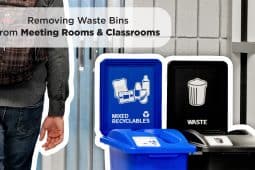The importance of protecting the environment came into focus for many of us over the past few decades – the first Earth Day in 1970 serving as the catalyst of change to a more environmentally conscious society. However the concept of recycling and conservation is much older than we think – there are many examples of people and businesses reducing their waste and being resourceful going as far back as the 1700s!
- In the formative years of America, colonists would collect rags and use them to make money – proving that a young America was both rebellious and resourceful!
- When cotton was scarce in the 1800s, scrap wool was used to make a variety of different things – blankets, military uniforms, and saddles and used as stuffing in mattresses. Immigrants and poor families also used to comb the streets for any discarded goods or materials that they could fix up and resell.
- Chicago meat-packers were sued in 1850 for throwing their by-products in the Chicago River – they got innovative and found valuable uses for their by-products.
- In the 1860s skeletons of slaughtered buffalo in the Northern Great Plains were shipped east where the bones were used in sugar and paper processing, button making or tuned into fertilizer.
- In the early 1900s, Waldorf Paper Mill opens in Minnesota and uses scrap paper from neighboring cities Minneapolis and St. Paul to produce their paper products.
- During World War I the US food administration proclaimed that “Food Will Win the War” and introduced “Meatless Monday” and “Wheatless Wednesday” providing more food to the war relief effort overseas. Over 13 million families took the pledge to observe these days while the US was involved in the war.
- During the great depression, many families were forced to recycle and conserve what they had – nothing was thrown out.
- The “Meatless” and “Wheatless” days were reinstated by President Roosevelt to aid the war efforts on the home front during World War II.
- Many posters were created to urge people to save their scrap food, paper and metal. Many of these now infamous propaganda posters went so far to say that wasting anything was unpatriotic and aiding the enemy!
- People were urged to return any used animal fat to their butchers since they could be used to make explosives to use overseas.
- President Harry S. Truman continued the ““Meatless” and “Wheatless” campaign after World War II was finished in order to help feed a war-ravaged Europe.
There were books published between the late 1800’s and early 1900’s (listed below) that showed many businesses were turning a profit out of what were previously waste products, or showed examples of industries that use virtually all their by-products (meat packing , metallurgy, textiles, soda and gas manufacture, and mineral oil)
The concept of recycling and conservations may not be new, but it is interesting to see that the reasons for doing so have changed. Presently, we recycle because we know the kind of disastrous effects that a wasteful society can have on the planet. In the past, people recycled not realizing the they were actually helping the environment, individuals and businesses recycled in order to save money, make ends meet, or were doing their duty to aid their country during the World Wars.
Published Works that Showcase the Early Days of Waste Reduction
On the Economy of Machinery and Manufactures by Charles Babbage (1835)
Waste Products and Undeveloped Substances: Or, Hints for Enterprise in Neglected Fields by Peter L. Simmonds (1862)
The Utilization of Waste Products: A Treatise on the Rational Utilization, Recovery, and Treatment of Waste Products of All Kinds by Theodor Koller (1902)
Millions from Waste by Frederick Talbot (1920)












